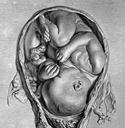Abigail Garner,
Families Like Mine: Children of Gay Parents Tell It Like It Is
(HarperPerennial, 2005).
Lisa Saffron,
What About the Children?
(Cassell, 1996).
With the culture wars raging over legal recognition of same-sex unions, advocates on both sides of the question have begun trying to examine the effects of the homosexual lifestyle on the children involved. Among the various others to have staked a claim in this field, two authors who support homosexual marriage and parenting are Lisa Saffron, a lesbian mother, and Abigail Garner, the daughter of a gay father. Both claim to be giving the children of homosexual parents an opportunity to speak for themselves without the pressure of politics. Yet beyond the real differences in their style, or their willingness to attempt an evenhanded witness, neither of these authors manages to allow the voices of these children effectively to escape the confines of their own foregone conclusions: that the homosexual lifestyle is self-justified in spite of any human fallout, and that to question or oppose it amounts to embracing bigotry.
Lisa Saffron is a self-identified lesbian. Her first book, Challenging Conceptions: Planning a Family by Self-Insemination, is a how-to manual for women who wish to conceive a child outside of a relationship with a man. Saffron herself conceived her daughter in this way, in part because she feared “the gender-based inequalities that would result from raising children in a heterosexual relationship sanctified by a patriarchal society.” Throughout the introduction to What About the Children, Saffron repeatedly asserts that families are what one wants them to be, regardless of the number, gender, or sexuality of the members involved. She proudly presents her eleven-year-old daughter as an example of happiness and stability, which she attributes, in part, to the child having three lesbian mothers and one gay father.
Saffron interviewed twenty children of homosexual parents ranging in age from eleven to sixty-six – a small sample whose numbers are mostly comprised of children of lesbian mothers. Not one of the children is adopted, and only one of the interviewees has a gay father who is the primary caregiver. Her explanation for this lack is that “men are not oriented around children, and gay men are no exception.” In any event, a scientific approach is not of primary importance to Saffron; she admits that when asked by journalists about the number of children who have homosexual parents, she wants only to give a number that would encourage people to be more accepting of homosexual parenting.
Saffron’s stated intent is to give these individuals an opportunity to speak of their unique experiences. In fact she devotes more than three quarters of the book’s pages to interviews. Strangely, not one person had anything negative to say about being a child of homosexual parents. Not one person had a troubled relationship with a homosexual parent (although some complained about a heterosexual parent and his or her intolerance of the homosexual parent). Many of the interviewees do portray the chaos of households in which parents frequently change partners, a phenomenon which is apparently common in (though not exclusive to) same-sex unions, but Saffron stops short of acknowledging this as detrimental. In fact, the only complaints these children express is against the social prejudice their parents suffer.
There is no discernible organization of these sessions or within the interviews themselves, and the testimony from these children is neither analyzed nor categorized. Saffron maintains that the children she interviews are not intended to be a representative sample, and yet her whole book is designed to draw conclusions for social change from her inferences. At the end of the book, in a chapter entitled “Psychological Development: What Do Children Need from Their Parents?”, Saffron draws five such “lessons” about child rearing based upon – and directly quoting – the preceding interviews:
1. Children do not need their parents to be heterosexual.
2. Children do not need one parent to be male.
3. Children need their parents to be happy.
4. Children are happier when their parents have an equal relationship.
5. Children learn positive moral values from lesbian and gay parents.
Thus, based on research from a very small sample of people, whom she came to know through her own personal involvement in her lesbian community, Saffron concludes that what children really need is to accept the lifestyle that she and her friends have chosen. But the fact is that these lessons are not conclusions that arise from her inquiry. They are simply the presuppositions that motivated her to produce a work of advocacy in the first place, and that appear stronger if they seem to be the results of scientific sounding research.
Whereas Lisa Saffron allows for no negativity regarding homosexual parenting, Abigail Garner is more willing to acknowledge that life as the son or daughter of a lesbian, gay, bisexual, or transgendered (LGBT) parent is not uniformly positive. Families Like Mine: Children of Gay Parents Tell It Like It Is is written from the viewpoint of a child who was raised by a gay father and heterosexual mother. Drawing on her own individual experience as well as the experiences of fifty other adult children of LGBT homes, Garner explains how a childhood such as hers necessarily had more difficulties than those of children who were not immersed in the homosexual community. She contends that while there is much discussion about the welfare of children raised by homosexuals, the opportunities to do actual research in this area have been limited, and that the culture of LGBT parenting itself has been evolving in ways that make such questions hard to answer.
Garner reports that children of LGBT families feel tremendous pressure to appear “normal” so that society will be convinced that gay and lesbian parents can raise well-adjusted children. This pressure even comes from within the families themselves; so much so, in fact, that often gay and lesbian parents are disappointed when their children “come out” as homosexual. She asserts that many within the LGBT community feel “that the rights of future gay parents depend on current gay parents’ ability to produce heterosexual children.” While Garner often notes that homosexual parents are sometimes complicit in this kind of prejudice, she asserts that the root of this problem is homophobia within the culture at large. She would like to see a LGBT community that embraces its differences and thus gives its children a more positive understanding of homosexuality as a culture.
Garner notes in her prologue that vocabulary can be difficult when discussing the varied relationships and attitudes one finds within and towards the LGBT community. For instance, words like “queer” and “gay,” while once understood as slurs, have, with the newer generation, been “reclaimed” by those who identify as homosexual and have taken on a positive meaning. Garner develops a few neologisms of her own that she uses throughout the book to describe a scale of prejudice against gays. She feels that “homophobia” is too broad a word, and so uses the term “homo-hostile” to describe those who are “intentionally hateful,” and “homo-hesitant” for those who are “simply uncertain.”
Throughout Families Like Mine Garner, to her credit, not only admits to many of the particular difficulties and problems faced by LGBT families, but tries to offer helpful guidance in managing them. She counsels gays involved in heterosexual marriages on the ways to “come out” to their families which take into account the feelings of those concerned, addresses those children who lived in fear of AIDS, and even discusses the effects on the children when gay and lesbian households break up. Here Garner has an opportunity to expose the real effects a child must suffer from changing family dynamics and the absence of a mother or father. But just as she approaches the difficulties suffered by these children, Garner veers off into a defense of homosexuality instead. For instance, in three chapters dedicated to the process of a parent “coming out” and the effects on the children and family, Garner’s most pressing concern is that the heterosexual spouse should process the separation with compassion and understanding, so that the children will not blame the gay parent’s homosexuality for the breakup of the home. She shows little compassion for the husband or wife who is left behind, and even sees a well-handled breakup as an “opportunity to enlist straight spouses as allies” in the LGBT cause.
Ultimately, Garner blames most of the problems she examines on a society or individuals she labels “homo-hostile.” The increased rates of depression or alcohol and drug abuse among “queer youth” are not actually explored, but simply blamed on homophobic bullying in school. She regards “the negative effects resulting from having LGBT parents” as “completely preventable”, by securing the sympathy of the larger community, rather than by addressing anything inherent within the family itself. For Garner, the only legitimate form of support for the children of LGBT families is advocacy for political and social acceptance of “alternatives to the dominant culture.”
Garner speaks as one who has lived through these experiences and weaves quotes from her interviewees into her narrative almost seamlessly. But apart from a general description of her interview pool (most came from LGBT discussion panels she has moderated during her decade of advocacy), very little background information is given about these adult children of homosexual families. It is as if they all agreed completely with Garner’s view, since the quotes she provides are only used to support her own arguments. While Lisa Saffron provides every word of her interviews, Garner prefers to speak for her interviewees instead, or rather to let their voices filter through insofar as they prove useful. The result may be a more pleasurable reading experience, compared to the sometimes wandering interviews in Saffron, but it does not ultimately provide a more balanced picture of the reality of the lives of children, or even necessarily a more evenhanded form of advocacy.
Even where Saffron and Garner are willing to acknowledge the existence of certain problems that exist in LGBT families, it is clear that they are not willing to face them. While Garner offers the promise of correcting this absence in Saffron’s analysis, she ultimately falls short of that promise. The unwillingness to consider that a child might see their LGBT parent’s action as a cause rather than a catalyst for the difficulties they experience reaffirms the authors’ commitment to the LGBT movement over its children. Given the very different testimony on such issues found in other authors, these works seem designed more to forestall critics of homosexual parenting than honestly and thoroughly to address the issues that children in these families must face.



